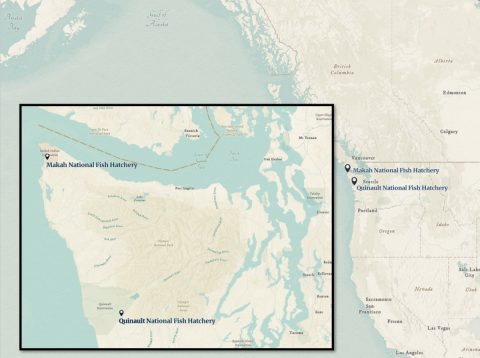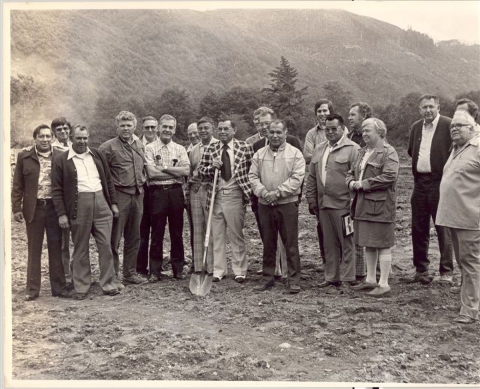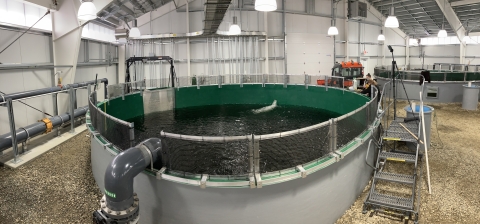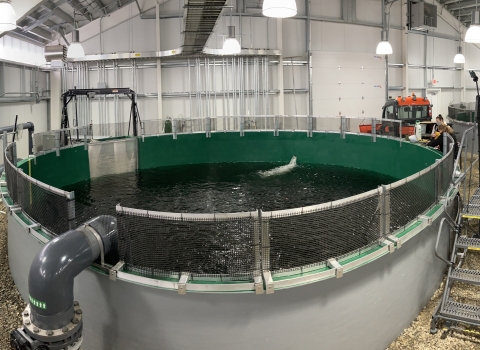The Olympic Peninsula is situated west of Seattle, Washington, touching the Pacific Ocean to the west, the Strait of Juan de Fuca to the north, and Puget Sound to the east. There is no farther western point in the contiguous United States than on the Olympic Peninsula, and if you glance north, you can easily see the Canadian shores of British Columbia on the near horizon.
There are places on the peninsula that one may perceive as wild and remote, altered only by time. However, in these wild, remote places, time bore changes to patterns of natural processes and climate, some observed to be more severe in magnitude and frequency, necessitating interventions and adaptations by people.
On the peninsula, two national fish hatcheries operate in partnership between Tribes and the U.S. Fish and Wildlife Service (Service) on Tribal lands. The Service works with the Makah Indian Tribe at the Makah National Fish Hatchery and the Quinault Indian Nation at Quinault National Fish Hatchery to restore and enhance depleted salmon and steelhead runs on Tribal and adjacent lands for Tribal cultural use, sport and commercial harvesting, and continued health of the ecosystem.
Makah National Fish Hatchery raises and releases fall Chinook salmon, coho salmon, and winter steelhead in the Tsoo-Yess River. At Quinault National Fish Hatchery, chum salmon, coho salmon, and winter steelhead are raised and released into Cook Creek, a tributary of the Quinault River. The Service supports these critical cultural and economic resources with the Tribes to fulfill U.S. treaty responsibilities in government-to-government partnerships to promote healthy ecosystems.
Managers at each of these hatcheries, and at the Makah Indian Tribe’s Hoko Falls Hatchery along the Hoko River, shared their observations, concerns, adaptations, and outlook for hope for managing the changes in climate that have affected the precious resources of salmon, steelhead, and more. They shared common observations of more severe and frequent weather patterns, increased water temperatures, decreased water availability associated with climate change climate change
Climate change includes both global warming driven by human-induced emissions of greenhouse gases and the resulting large-scale shifts in weather patterns. Though there have been previous periods of climatic change, since the mid-20th century humans have had an unprecedented impact on Earth's climate system and caused change on a global scale.
Learn more about climate change , and anomalies that are still to be explained. Though salmon are a focal species at these hatcheries, they are not the only ones affected.
“We start the conversation with salmon, but it’s more than just salmon,” said Stephanie Peterson Martin, Makah Tribal member and habitat division manager and ecologist with Makah Fisheries Management.
Martin has been working for the Makah Tribe for 17 years. Formerly working in timber harvest, she is the nexus between land management and protection of Tribal resources.
“It’s not just about salmon overcoming challenges, it’s about how the environment is overcoming the challenges. We sometimes forget that salmon recovery is indicative of larger issues. The issue is really about the protection of the habitat, and everything is connected,” said Martin.
“We know that this land is always changing. The issue with climate change is the rate of change.”
Climate Challenges: Water, Fish Health, and Unknowns
Water: Too much, too little, or too warm
Service hatchery manager Kristin Bates reflected upon her recent years at Makah National Fish Hatchery. Every year for the past three years, Makah National Fish Hatchery has sustained massive floods at a scale and frequency not seen before. For context, an employee who has been at Makah National Fish Hatchery for 30 years has seen five floods of this large magnitude, yet three of them have occurred in the past three years.
High flows and flooding can not only damage hatchery infrastructure, but it can also damage habitat, moving large amounts of sediment and gravel that can potentially bury eggs.
Bates shared another challenge of increased water temperatures, seeing unprecedented 74-degree water when 54 degrees is ideal temperature for salmon. In some places where logging has occurred, those areas that used to be shaded are now exposed to more direct sunlight, heating the ground and drying out groundwater.
At the Quinault National Fish Hatchery, hatchery manager Dan Fielding discussed that the issues at Quinault are less about the temperature of water and more about shortage of it. Working side by side with the Tribe, Fielding has worked with some who have put in 50 years to the program and has heard countless stories from those who have seen it all — they say there was historically more water and better conditions for fish.
Lack of water sometimes leaves adult salmon unable to return to hatcheries, and they seek deep pools to wait for more rain and flows. These pools may not be the ideal conditions for maturing fish, and sometimes the water does not come, and they cannot return.
Fielding shared that throughout his life, working with his passion for hatcheries in numerous states across the west, he has observed the changing climate affecting not only salmon, but also the environment around him. He recognizes that climate change is undeniable and one of the most real challenges that hatchery professionals are going to face. At Quinault National Fish Hatchery, they are trying to minimize the impacts or adapt to the changes.
Drought coupled with warmer water pose numerous challenges to rearing and supporting healthy fish. These unusually high temperatures create a welcoming environment for warm-water species that would otherwise not be there. Warmer water encourages some bacteria and parasites to reproduce at higher rates; as a result, parasite loads increase and fish health becomes an issue.
Fish Health
These fish start and end their lives at the hatcheries; but what happens in the years they spend in the ocean before returning? They spend a few years in the ocean before migrating back to their spawning grounds, in this case, the hatcheries where they were first released. Their time in the ocean factors into if, when, and in what condition they return.
“Seeing the fish return to the river each year is magical. Knowing they made it home is heartwarming and a joy shared by all,” said Bates. “Harvesting and spawning, you get very invested in the life of the adults. When they return, you focus on the eggs, the fish culture and care, and feed. We hope that their time with us is not stressful.”
Bates posed this question about fish returning to the hatcheries: “Whose health backpack got too heavy and can’t make it home?”
Dr. Christine Parker-Graham is one of two veterinarians in the Pacific Region’s Fish Health Program. She uses a descriptive analogy of fish health “backpacks” to consider a fish’s life journey from start to finish and how this contributes to their overall health and ability to survive.
“I think of fish carrying around backpacks for their whole lives. Everything that happens to them adds or subtracts from their backpack. Good water quality, good feed, and excellent husbandry takes weight out of their backpack, whereas things like warm water, parasites, predator stress, and poor feed add weight to their backpack. With one of these things alone, their backpacks are still light enough for them to carry and be healthy, but if we start adding multiple weights from the list, their backpacks can get so heavy they can’t carry them anymore.”
Parker-Graham continued, “When this happens, we usually see clinical illnesses emerge. Our job as a fish health-hatchery team is to keep those backpacks light as possible.”
Unknowns
Hatchery managers are in tune with changes that occur over time and sometimes observe things that are out of the norm yet still without clear explanation.
Over the years, the hatcheries have been observing skewed sex ratios of male to female fish. In one example, though Makah National Fish Hatchery met their target of number of returning Chinook salmon adults in the last two years, the salmon were only roughly 25 percent female; typically, they would be half female and half male.
Joe Hinton, hatchery manager at the Makah Tribe’s Hoko Falls Hatchery, noted the same issue last year. The adult Chinook salmon that returned also showed skewed sex ratios. As observed at Makah, the males were much greater in number than females, but at Hoko Falls, they counted fewer than 30 females out of 1,000 males.
The causes of this are not fully known, and though they may not be expressly climate-related, this is one example of the additional questions and potential challenges these fish and hatchery managers face.
Adaptations and Hope for the Future
The people on the ground who observe, manage, and use these important resources are continuing to find new and innovative ways to adapt to the changes.
“If you get fish people together to try to fix something, there is determination and passion to do it. We would not be doing the fish a service by shying away from a challenge. The fish can’t speak for themselves,” Bates said.
Whether finding more cost-effective ways to install new technology and infrastructure, investigating desalination and wave energy, using more efficient pump systems to capture more water, pumping cooler water from rivers, modifying fish rearing practices and staying on top of fish health issues — the hatcheries continue to investigate and apply solutions to fulfill their important missions. These adaptations are occurring at national fish hatcheries across the region and Service-wide.
For example, at Leavenworth National Fish Hatchery the Service and partners have implemented a pilot project to use Partial Recirculating Aquaculture Systems for rearing fish. This technology allows for the reconditioning and reuse of clean water, saving a considerable amount of water compared to the more traditional raceway approach.
However, new technology and infrastructure is costly. With limited resources, hatchery managers are often doing what they can to be creative and resourceful with what they have.
At Quinault National Fish Hatchery, Fielding sees hope in the younger generation who are looking at challenges with new ways of problem solving and adapting to new circumstances.
“We will adapt, tweak systems and productions, and be in tune with mother nature,” said Fielding.
Hinton at the Hoko Falls Hatchery shared that this conversation and this story gives him hope, that there are people interested in what their challenges and perspectives are. “This is a good step that can’t do anything but help, for everyone to work together to find common solutions, not knee-jerk solutions. It is not a simple problem to solve, it will take a multi-faceted solution,” he said.
At Makah National Fish Hatchery, Bates reflected on working closely with the Makah Tribe and emphasized the importance of institutional knowledge.
“Even with the challenges, when you’re not doing it alone, that is really important. With the Tribe’s commitment to the resource and their voice along with the Service and people on the ground, we can get really innovative,” she said. “Learning from the past helps you prepare for the future.”
And Martin with Makah Fisheries Management holds hope in stories of resiliency.
“As a Tribe, we have been here since time immemorial to be stewards of the landscape, and it is a responsibility — not a right. I have to have faith that we will be able to fulfill that responsibility. We have stories from the past of adaptability and resiliency, and that gives me hope for the future,” she said.
“As a people, we are not only relying on this land, we are also a part of this land, we are a part of its ecology. If the ecosystem is not healthy, then we are not either. Everything is one.”
The Service is committed to addressing and adapting to the impacts of a changing climate and is conducting climate vulnerability assessments to evaluate climate change vulnerability at National Fish Hatcheries. The Service worked with co-managers with the Makah Tribe to complete the Makah National Fish Hatchery Climate Change Vulnerability Analysis. These assessments are identifying the most significant adaptation risks at each hatchery and planning proactive response strategies to address the risks.
The Alaska, Pacific, and Pacific Southwest Regions of the U.S. Fish and Wildlife Service have collaborated to tell stories of climate-related challenges, adaptations, and outlook for hope for Pacific salmon species from multiple perspectives. Learn more about the efforts of the Service, Tribes and other partners to help Pacific salmon overcome the challenges they face due to climate change: New Challenges in the Struggle to Save Pacific Salmon
















